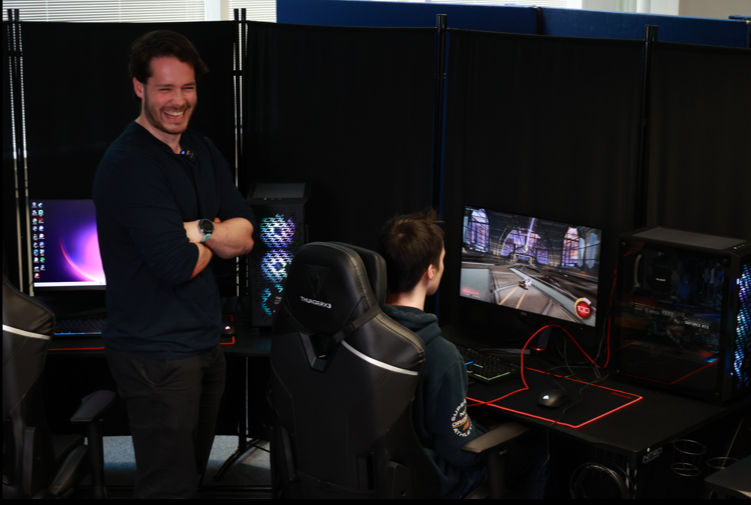Fight or Flight Gaming: Are you a top-down or bottom-up processor?
- Abbott Sport Psychology
- Oct 31, 2019
- 3 min read

We’ve all been in a situation where we have zoned out of a low-stakes match and found ourselves still getting kills, objective points or goals, and sometimes even doing better than usual. Think of it like driving the same route to work/school every day, after a while it begins to feel natural and you can find your mind wandering and before you know it you’ve made it to your destination. That’s because the bottom-up processing centres in your brain decided to take the wheel, and your top-down processes began to wander.
Bottom-up processes refer to the more primal, instinctual aspects of subconscious thought whilst top-down refer to the highly advanced frontal areas of the brain which can consciously influence attention and control(1).
Take the classic illusion at the top of the page, what did you see first? Whether it was the saxophonist or the face, what you initially saw was a result of bottom-up processing where your brain rapidly interprets the environment around you. However, if you engage your top-down processes and instruct yourself to see the other part of the illusion, you can. This is how the trade-off works, bottom-up processes are instinctual and rapid, usually concerned with fight or flight(3), whilst top-down are more rational and calculated but slower. Both are essential for optimal performance in esports, just in different ways.
Now you might be thinking how could this ever be beneficial to me whilst gaming? Just think about a time when you blew a small problem out of proportion and began to overthink the potential outcomes, that is top-down interference. Now this can have a huge detrimental effect on your game if you can’t tune out this stream of consciousness which can interfere with basic practised rhythms, just like how people can freeze on stage despite hours of practise beforehand. Or conversely, think about a time you fell for a decoy or a trap online because you didn’t rationally think all options through? That’s bottom- up interference.
It is essential that both styles of processing are trained if you want to boost your performance. In a high pressure low time situation, such as when you’re the defending team and the bomb has just been planted, it can beneficial to engage the instinctual bottom-up processing in reaction to opposition movement directly after the plant and heightened awareness when attempting to defuse. This can be buffed over time through repeated practise and habit forming. This is the sort of processing elite cricketers use when they subconsciously calculate where the ball will land just from the bowler’s subtle body cues alone, and how you may have got a kill in Siege or CS:GO based purely on reaction when startled, rather than calculation and strategy.
However, being a bottom-up processor alone isn’t enough, if all pro gamers were solely bottom-up you’d only ever see reactionary gaming based on instinct, rather than the complex nail-biting strategic games you often see at the peak level of performance.
Now the perfect balance is using top-down processing to create and learn routines to boost performance, and eventually allowing the bottom-up processes to take control of these so it is no longer a slow, energy consuming conscious task. This allows strategy to go from being self-talk and language based, to rhythm and gut feeling based, in turn becoming a much faster process.
So how can you train yourself to be a more bottom-up processor?
Routine, routine, routine. This is one of the most effective ways to turn conscious processing into subconscious. Just compare when you first learned to ride a bike to how you ride one now, at the beginning you were probably hyper-conscious of every move you made whilst trying to stay balanced, but after much practice you barely think of balance whilst you’re coasting down a road.
Develop routines that work for you, which include triggers for automated response and practise them over and over. Eventually you’ll find that when you use your trigger, your top-down processing will disengage and shift focus, allowing the bottom-up processes to take up the slack. So next time you’re playing your chosen game try and pinpoint which type of processing you use most and whether it would suit you better to be more bottom-up, or top-down, and maybe you’ll find you can tweak your processing to give you the advantage.
Feel free to get in touch through the contact page for further information regarding articles, or if you or your team are interested in working with Abbott Sport Psychology.
Author: Callum Abbott Bsc, MSc ,MBPsS
References:
1Buschman, T. J., & Miller, E. K. (2007). Top-down versus bottom-up control of attention in the prefrontal and posterior parietal cortices. science, 315(5820), 1860-1862.
2Retrieved from kidsmathsgamesonline.com.
3Solomon, E. P., & Heide, K. M. (2005). The biology of trauma: Implications for treatment. Journal of Interpersonal Violence, 20(1), 51-60.
4Müller, S., Abernethy, B., & Farrow, D. (2006). How do world-class cricket batsmen anticipate a bowler’s intention?. The quarterly journal of experimental psychology, 59(12), 2162-2186.



Comments